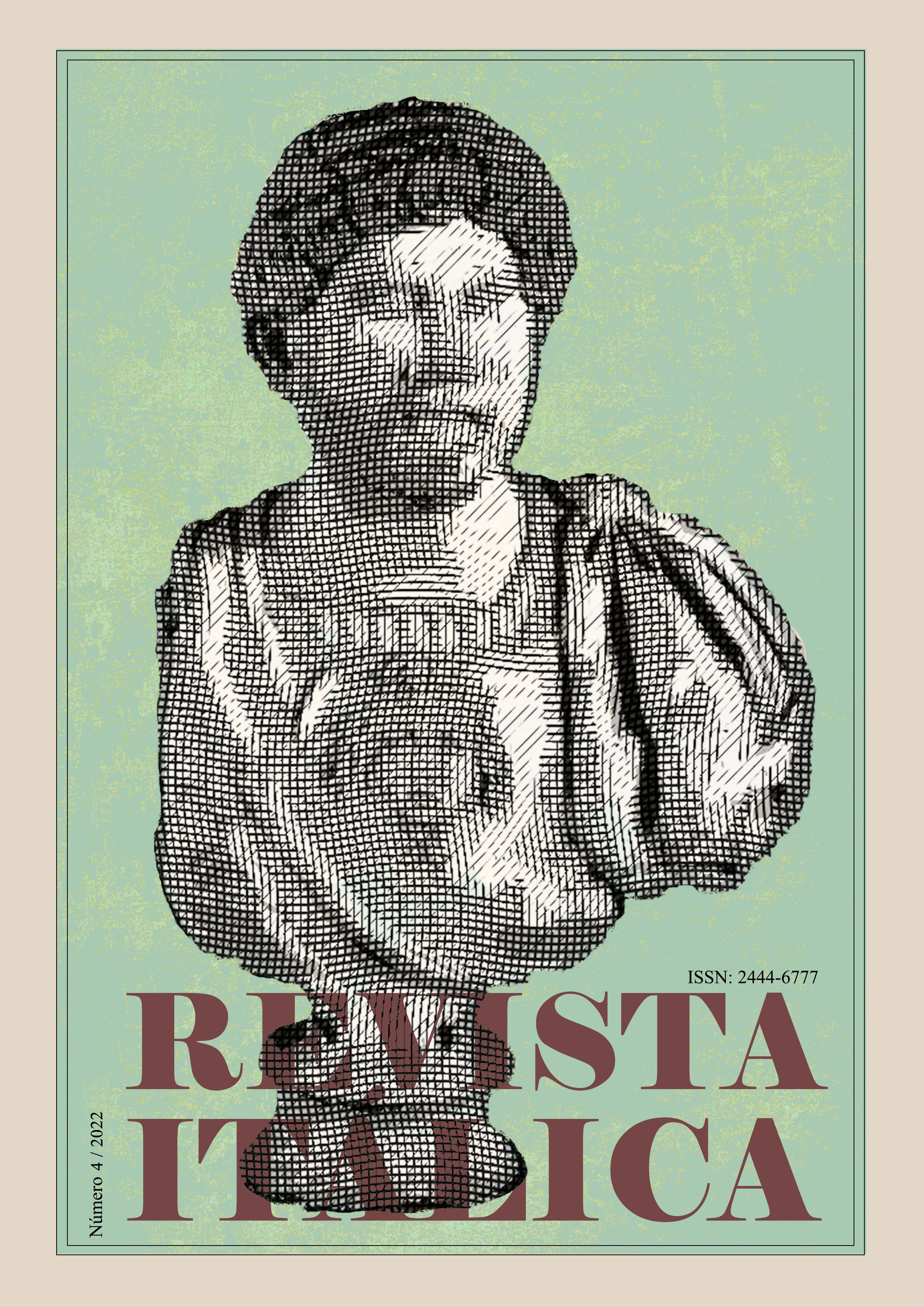La religión en la novela griega: Análisis de las Efesíacas de Jenofonte de Éfeso
Palabras clave:
Jenofonte, Efesíacas, Éfeso, novela griega, religión, procesión, sacrificio, oráculoResumen
El presente trabajo se centra en el análisis del componente religioso de las Efesíacas, novela griega escrita por Jenofonte de Éfeso en torno al siglo II. El estudio realizado se organiza en torno a tres bloques principales: la procesión, el sacrificio y los oráculos. Así, se analizan cada uno de los pasajes en los que se hace referencia, explícita o implícita, a este tipo de prácticas rituales que dominaban la vida religiosa de los ciudadanos en la Antigüedad.
El objetivo último de este estudio es exponer cómo la religión dentro de la novela de Jenofonte de Éfeso tiene un papel fundamental que influye no solo a nivel estilístico, sino también argumentativo.
Descargas
Citas
BIERL, A. (2013): “Introduction”, en M. P. Futre, A. Bierl y R. Beck (eds.), Intende, Lector - Echoes of Myth, Religion and Ritual in the Ancient Novel, Berlin, De Gruyter, pp. 1-4.
BONNECHERE, P. (2007): “Divination”, en D. Ogden (ed.), A companion to Greek Religion. Malden, Blackwell publishing, pp.145-159.
BOWIE, A. (1995): “Greek sacrifice: forms and functions”, en A. Powell (ed.), The Greek world, Nueva York, Routledge, pp. 463-482.
BREMMER, J. N. (2007): “Greek normative animal sacrifice”, en D. Orgen (ed.), A companion to Greek religion, Malden, Blackwell, pp. 132-144.
BRUIT, L, y SCHMITT, P. (2002): La religión griega en la polis de la época clásica, (Trad. M. F. Díez Platas), Madrid, Akal.
BURKERT, W. (1991): Religión griega arcaica y clásica, (Trad. H. Bernabé). Madrid, Abada.
CHANIOTIS, A. (2011): “Emotional Community through Ritual. Initiates, Citizens, and Pilgrims as Emotional Communities in the Greek World”, en A. Chaniotis (ed.), Ritual Dynamics in the Ancient Mediterranean: Agency, Emotion, Gender, Representation. Stuttgart, Steiner Verlag, pp. 264-290.
EASON, C. (2009): Nuevos misterios del Antiguo Egipto, (Trad. E. Gandía) Barcelona,
Robinbook.
FARNELL, L. R. (1977). The cults of the Greek states vol. V, Nueva York, Caratzas brothers.
GORDON, R. (2015): Apis. Disponible en: https://www.oxfordreference.com/view/10.1093/acref/9780199545568.001.0001/acref-9780199545568-e-586?rskey=yOrbQE&result=1
HERNÁNDEZ, D. (2008): Oráculos griegos, Madrid, Alianza.
MACLEAN, G. (1991): The sacred identity of Ephesos. Foundation myths of a Roman city, Londres y Nueva York, Routledge.
MASON, C. (2006): “The nuptial ceremony of Ancient Greece and the articulation of male control through ritual”, Classics Honors Projects (5). Disponible en:
MERKELBACK, R. (1962): Roman und Mysterium in der Antike. Berlin, C.H. Beck.
NAIDEN, F. (2015): “Sacrifice”, en E. Eidinow y J. Kindt (eds.), The Oxford handbook of ancient Greek religion, Oxford, Oxford University Press, pp. 463-474.
NILSSON, M. P. (1906): Griechische Feste von religiöser Bedeutung, mit Ausschluss der
Attischen, Leipzig, B. G. Teubner Verlag. Disponible en:
https://archive.org/details/griechischefest01nilsgoog.
O'SULLIVAN, J. N. (1995): Xenophon of Ephesus his compositional technique and the birth novel, Berlín, De Gruyter. Disponible en: https://ebookcentral.proquest.com/lib/bupoebooks/detail.action?docID=3044215.
PARKER, R. (2016): “Seeking advice from Zeus at Dodona”, Greece and Rome, 63(1), pp. 69-90.
ROJAS, M. D. (2014): “Aspectos de la religión en la novela erótica griega”, Nóesis: Revista de Ciencias Sociales y Humanidades, 3(45), 140-176. Disponible en: http://erevistas.uacj.mx/ojs/index.php/noesis/index?s=Aspectos+de+la+religi%C3%B
n+en+la+novela+er%C3%B3tica+griega
STONEMAN, R. (2011): The ancient oracles: making the Gods speak, New Haven y Londres, Yale University Press.
SUÁREZ, E. y E. PÉREZ, (2013): “Love, Mysteries and Literary Tradition: New Experiences and Old Frames”, en: R. Beck, A. B. Bierl & M. F. Pinheiro (eds.), Intende, Lector - Echoes of Myth, Religion and Ritual in the Ancient Novel, Berlin, De Gruyter, pp. 51-66.
ThesCRA. (2004): Thesaurus cultus et rituum antiquorum). I. Processions, sacrifices, libation, fumigations, dedications, Los Ángeles: The J. Paul Getty Museum, Basel, Fondation pour le Lexicon Iconographicum Mythologiae Classicae LIMC.
TUÑÓN, J. (1979): “Introducción”, Efesíacas, Madrid, Gredos, pp. 217-229.
WHITMARSH, T. (2008): “Introduction”, en T. Whitmarsh (ed.), The Cambridge companion to the Greek and Roman novel, Cambridge, Cambridge University Press, pp. 1-14.
ZEITLIN, F. (2008): “Religion”, en T. Whitmarsh (ed.), The Cambridge companion to the Greek and Roman novel, Cambridge, Cambridge University Press, pp. 91-108.
Fuentes primarias:
HOMERO. (1978): Himnos Homéricos: La Batracomiomaquia, (Trad. A. Bernabé), Madrid, Gredos.
HOMERO. (1993): Odisea, (Trad. J. M. Pabón), Madrid, Gredos.
JENOFONTE. (1979): Efesíacas, (Trad. J. Mendoza), Madrid, Gredos.

Descargas
Publicado
Cómo citar
Número
Sección
Licencia
1. Los autores conservan los derechos de autor y garantizan a la revista el derecho a ser la primera en publicar el trabajo y a hacerlo bajo una licencia “Creative Commons Reconocimiento-No Comercial 3.0 España” (CC-by-nc-sa) , salvo indicación en contrario.
2. Esta licencia permite a otros compartir, copiar, distribuir y comunicar publicamente el trabajo, así como hacer obras derivadas siempre y cuando se atribuya la obra al autor o autores, no se utilice con fines comerciales y se comparta bajo la misma licencia.
Puede consultar desde aquí la versión informativa y el texto legal de la licencia. Esta circunstancia ha de hacerse constar expresamente de esta forma cuando sea necesario.
3. Los autores pueden establecer por separado acuerdos adicionales para la distribución no exclusiva de la versión de la obra publicada en la revista (por ejemplo, situarlo en un repositorio institucional o publicarlo en un libro), con un reconocimiento de su publicación inicial en esta revista.
4. Se permite y se anima a los autores a difundir sus trabajos electrónicamente (por ejemplo, en repositorios institucionales o en su propio sitio web) antes y durante el proceso de envío, ya que puede dar lugar a intercambios productivos, así como a una citación más temprana y mayor de los trabajos publicados (Véase The Effect of Open Access) (en inglés).

 Universidad Pablo de Olavide
Universidad Pablo de Olavide